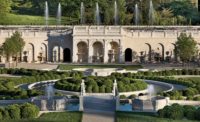Bancroft Construction’s Greg Sawka sat quietly in the back of the room listening to the March 2 briefing about the $250-million Longwood Gardens makeover in Kennett Square, Pa. At the conclusion of the briefing, held in the New York City office of project architect WEISS/MANFREDI Architecture/Landscape/
Urbanism, he described to ENR his “once-in-a-lifetime” project—the transformation of the 17-acre heart of the 1,077-acre landmark garden, about 12 miles from Wilmington, Del.
The project is “unique in the built environment” for it combines landscape and horticulture into more than a dozen miniprojects, interconnected by common back-of-the-house infrastructure, all of which is hidden below grade, said Sawka, the construction manager’s president and CEO.
Bancroft started building the $215-million job in early 2021 and expects to reach substantial completion in July 2024. “Weaving the complexity and sequencing the work with an active garden across the fence line,” has been challenging, said Sawka.
The centerpiece and largest single element of the project—called Longwood Reimagined—is a 32,000-sq-ft glasshouse designed by WEISS/MANFREDI, with gardens, pools and fountains designed by Reed Hilderbrand Landscape Architects. Called the West Conservatory, it will appear to be a “floating” garden of planted islands, canals and low fountains.

The West Conservatory (foreground) is the centerpiece of a 17-acre redevelopment of Longwood.
Courtesy of WEISS/MANFREDI with Reed Hilderbrand for Longwood Gardens
The conservatory’s steel frame, composed of “structural trees” engineered by Magnusson Klemencic Associates, is erected. Crews are currently installing the nearly 2,000 glass panels, each with a bird-safe fritted pattern.
Longwood Reimagined is the largest and most ambitious part of the institution's grand plan, issued in 2010. The current $250-million development is funded by the Longwood Foundation and tax-exempt bonds issued by Longwood Gardens in 2021.
Called “A World Apart,” the grand plan provides a 40-year framework for the growth of the institution, which opened to the public in 1921. Developed in partnership with West 8 Urban Design & Landscape Architecture and Weiss/Manfredi, the plan combines new visitor amenities and experiences with infrastructure and operational upgrades.
More Operationally Sustainable
WEISS/MANFREDI partner, Michael Manfredi, says one design goal is to make the glasshouse more operationally sustainable by “introducing a number of passive strategies.” For example, a geothermal system consisting of 10 earth ducts—each 3 ft in diameter and 250 ft long—will be buried outside the conservatory and provide year-round passive tempering of fresh air, he says.
During the warm months, the building will solely rely on natural ventilation rather than mechanical cooling. There will be a 10-ft-tall operable vertical façade. Outside air will flush out heat buildup, with hotter air rising and escaping through roof openings that cover 15% to 20% of the overhead surface area.
An automated shading system will also reduce solar heat gain during the hottest days of the summer, says the architect. During cold months, the shading system will act as a thermal blanket, operating during evening hours to trap heat inside and reduce radiative heat loss.
A water conservation system will collect stormwater from the roofs of the West Conservatory and the adjacent education and administration building and capture overflow from the outdoor water features. Water collected from these systems will be stored in underground tanks and later recirculated through the water features and portions of the restrooms.
Founder Pierre S. du Pont opened the original greenhouse structure, designed by J. Walter Cope, in 1921. In modern times, beginning in 2010, a new East Conservatory Plaza opened that features the largest green wall in North America, according to Longwood. In 2011, the institution installed a 10-acre solar field and three years later, it expanded the Meadow Garden from 40 to 86 acres of native wildflower plantings and trails. A revitalized Main Fountain Garden, called the crown jewel of the fountain collection, was unveiled in 2017.
The garden has always been “in a process of change and evolution,” on a mission to “make people happy,” said Longwood president and CEO Paul Redman, at the briefing.




Post a comment to this article
Report Abusive Comment